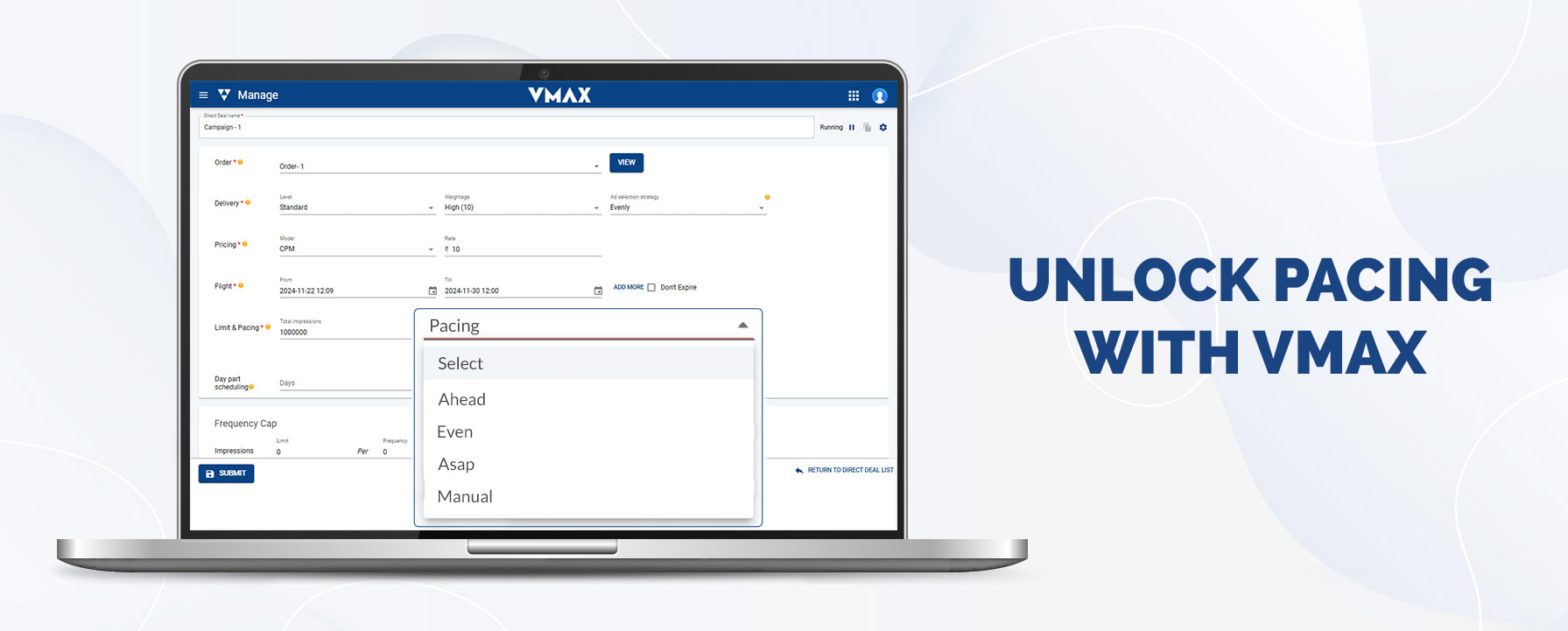
In the world of digital advertising, premium publishers face the delicate challenge of balancing revenue optimization, user experience, and advertiser satisfaction. One of the most critical tools at their disposal is campaign pacing—the process of controlling how ad impressions are delivered over a campaign's flight period.
Pacing directly impacts a publisher's ability to meet advertiser goals while maximizing the value of their inventory and ensuring a seamless user experience. Let’s dive into why pacing is essential for publishers and explore the four primary pacing strategies—Ahead, Even, ASAP, and Manual Daily Caps-along with how to select the right option.
Why Campaign Pacing Matters for Publishers
-
Revenue Optimization - Strategic pacing ensures optimal utilization of ad inventory, allowing publishers to achieve the highest yield. By spreading impressions wisely, publishers can accommodate premium campaigns while leaving room for high-value bids later in the flight period.
-
Advertiser Satisfaction - Advertisers expect their campaigns to deliver on objectives—whether it’s impressions, clicks, or conversions. Pacing helps publishers meet these goals consistently, building trust and ensuring repeat business.
-
Enhanced User Experience - Poor pacing can lead to overloading users with the same ad repeatedly (ad fatigue) or failing to deliver enough ads to sustain the desired campaign impact. Both scenarios can hurt user engagement and publisher reputation.
-
Adaptation to Traffic Fluctuations - Website traffic varies by time of day, day of the week, and season. Effective pacing helps publishers adapt to these fluctuations, ensuring that campaigns perform well across varying conditions.
The 4 Types of Pacing Strategies
-
Ahead Pacing
-
What It Does: Frontloads impressions early in the campaign period.
-
Best For: High-priority campaigns or those with tight deadlines.
-
Example Use Case: A flash sale event where achieving impressions early drives conversions.
-
Publisher Benefit: Minimizes risk of under-delivery due to unexpected traffic dips later in the campaign.
-
-
Even Pacing
-
What It Does: Distributes impressions evenly over the entire flight period.
-
Best For: Long-term branding campaigns or when consistent exposure is critical.
-
Example Use Case: A month-long awareness campaign for a product launch.
-
Publisher Benefit: Maintains steady ad presence, ensuring balanced inventory usage and preventing ad fatigue.
-
-
ASAP Pacing
-
What It Does: Delivers impressions as quickly as possible.
-
Best For: Urgent campaigns or when there's a risk of inventory going unsold.
-
Example Use Case: A campaign promoting a one-day-only event.
-
Publisher Benefit: Maximizes revenue by utilizing inventory immediately without waiting for later traffic.
-
-
Manual Daily Caps
-
What It Does: Imposes specific daily limits on impressions or budget spend.
-
Best For: Campaigns requiring granular control over delivery patterns.
-
Example Use Case: A campaign targeting weekend traffic or specific hours of the day.
-
Publisher Benefit: Provides flexibility to align ad delivery with audience behavior and advertiser preferences.
-
Choosing the Right Pacing Strategy
When selecting a pacing strategy, publishers must consider:
-
Campaign Objectives: Is the advertiser focused on awareness, engagement, or conversions?
-
Flight Period: How long is the campaign active?
-
Inventory Availability: Is there a risk of running out of impressions?
-
Audience Behavior: Are there known patterns in user traffic during the campaign?
Here’s a quick guide to help publishers decide:
| OBJECTIVE | RECOMMENDED PACING |
|---|---|
| Urgent Delivery | ASAP Pacing |
| Consistent visibility | Even Pacing |
| Maximize early impressions | Ahead Pacing |
| Granular control needed | Manual Pacing |
VMAX Pacing Implementation
VMAX supports all four pacing options for campaigns. For ASAP pacing, no daily limits are applied. However, for Manual pacing, the campaign manager's specified daily limits are strictly followed.
For campaigns using Ahead and Even pacing, the daily limit is dynamically calculated at the start of each day based on advanced scheduling parameters such as days of the week and hours of the day.
In the case of Even pacing, the required hourly delivery is determined based on the remaining hours and pending delivery, with the daily limit set according to the available hours for that day. For Ahead pacing, a similar approach is followed, aiming to deliver 70% of the campaign's volume within the first 50% of the available hours.
The Publisher’s Edge
Campaign pacing is more than just a technical feature of an ad server—it’s a strategic lever that allows publishers to:
-
Build stronger advertiser relationships by delivering on campaign promises.
-
Enhance monetization through smarter inventory utilization.
-
Improve user satisfaction by avoiding ad saturation or scarcity.
By mastering pacing strategies and aligning them with advertiser goals and traffic trends, publishers can stay ahead in the competitive ad ecosystem.
Curious to try out VMAX's incredible features? Get in touch!
